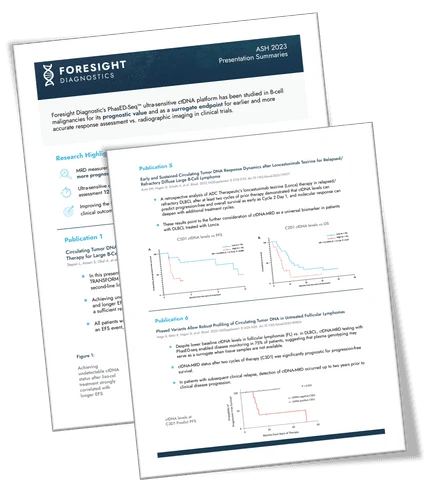
delivers early and accurate response assessment using ultra-sensitive ctDNA-MRD technology
Foresight CLARITY is an ultra-sensitive, liquid-biopsy platform that detects minimal residual disease (MRD) across multiple indications using our proprietary PhasED-Seq™ circulating tumor DNA (ctDNA) technology.
Our research to date shows that Foresight CLARITY can detect residual disease earlier than imaging and conventional liquid biopsy methods, Foresight CLARITY offers unprecedented insight into cancer relapse and recurrence.
30-40% of DLBCL patients are likely to relapse 1-2 years after first-line therapy.1
Foresight CLARITY may predict relapse risk immediately at the end of treatment. That’s up to 200 days sooner than relying on PET/CT for relapse diagnosis.2
Foresight CLARITY
Foresight CLARITY for Lymphoma is an off-the-shelf MRD assay that detects extremely low levels of ctDNA from plasma based on patient-specific phased variants.
Foresight CLARITY
Foresight CLARITY for Solid Tumor is a custom, tumor-informed MRD assay that offers a high degree of sensitivity based on patient-specific phased variants that are identified with whole-genome sequencing.
Foresight CLARITY is for research use only. Not intended for use in diagnostic procedures.
Interested in other indications? Contact us to discuss.
Contact UsLOD95: Limit of detection with 95% confidence.
Performance characteristics shown for lymphoma. These performance characteristics have not been reviewed by the FDA.
MRD detected by Foresight CLARITY accurately predicted response as early as fifteen days into 2L liso-cel therapy in DLBCL.3
Across multiple LBCL studies, Foresight CLARITY accurately stratified patient response at end of treatment, correlating analytical sensitivity with clinical sensitivity. Results showed that integrating MRD as a surrogate endpoint for response assessment may accelerate clinical trials by up to 12 months as opposed to PFS alone.4,5
A prospective real-world study powered by Foresight CLARITY found that ctDNA-MRD levels were prognostic for both progression-free survival and overall survival at interim and end-of-treatment timepoints. In cases with discordant MRD and PET/CT assessments, MRD was shown to be the more prognostic measure, suggesting opportunities for MRD to be a possible alternative to PET/CT for lymphoma response assessment.6

From research to diagnostic development, Foresight CLARITY can help inform critical decision-making steps related to study design, execution, and analysis.
Interested in accessing Foresight CLARITY for Investigator Initiated Studies? Let’s chat.
David Chang, M.D, Ph.D., CEO Allogene Therapeutics
These performance characteristics have not been reviewed by the FDA